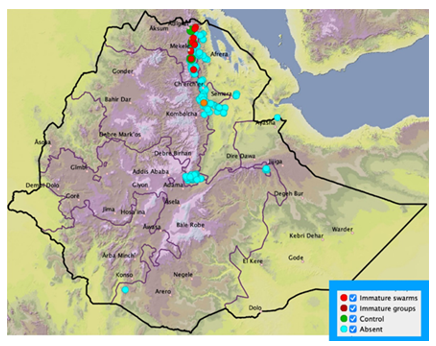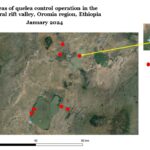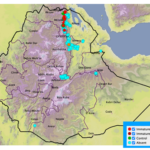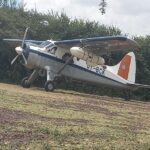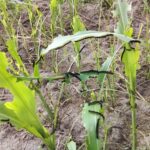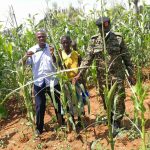The Desert locust situation was calm in the region except where numbers of immature groups, low-density adults persisted in some locations scattered solitary locust were seen Eritrea, Ethiopia, Somalia, and Sudan.
Generally, control operations treated 1,192 ha, in Eritrea and A total of 849ha treated with 452 liters of ULV pesticides in Sudan.
In Ethiopia the Desert Locust reports were received first on 26 July, where some immature adults were found in the lowland area in western Afar north of Chifra in Ethiopia. (refer also ECLO)
During the first week of August, a few small immature swarms appeared on the Tigray highland east of Adigrat and some moved further south to southeast Tigray near Korem. During the second week, a few small immature swarms were on the highland in the central parts of eastern Tigray to the north and south of Mekele.in general currently desert locust is reported in Four regions, (Afar, Amhara Tigray and recently from Oromia) in eleven zones 30 districts totally 111, 122ha were surveyed 15,883 ha was reported as an area where the locusts were moving out of these a total of 732ha was controlled.
FORECAST.
The number of groups and swarms in Tigray is becoming low and more locusts are not expected to come from Eritrea. Since this is the summer breeding time, Desert Locust adults prefer to become mature, copulating and laying in sand areas in plains and wadis usually in the interior of Sudan, western lowland of Eritrea and perhaps in the lowland areas of Afar in Ethiopia rather than clay soil in the mountains of the highland areas of Tigray and Amhara.
Once locusts become mature, it will take about two weeks for hatching to occur and hoppers will take about six to eight weeks before they become adults, probably about the end of October. (FAO, MoA and DLCO-EA)
DLCO-EA Contribution to wards the management
- Participate as technical committee where the committee discuss the current situation and proposes recommendation for, deployment of logistics, technical advices, and identification of priority areas of intervention for decision.
- Deployment of aircraft: DLCO-EA deployed one air craft to kombolcha for aerial survey and control

